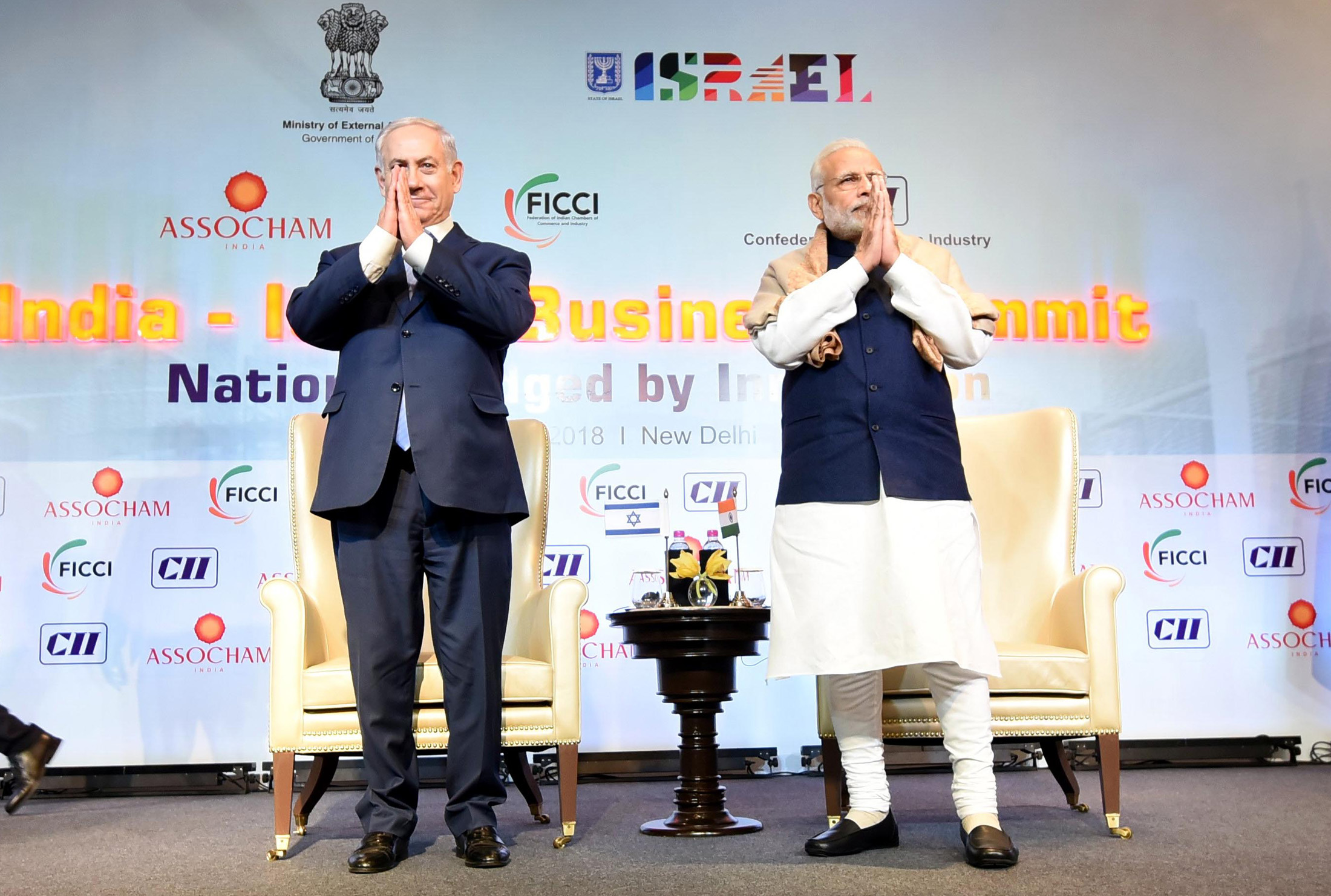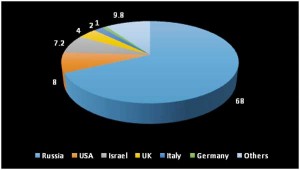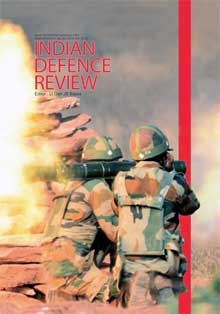Indo-Israel defence relations have followed a very constructive path over the years, with the joint design development and production initiative of MRSAM missiles between the DRDO and IAI, Israel (2006). This initiative between the DRDO and Israel has facilitated the Indian designers and scientists to gain invaluable insight for designing such systems in India. This successful Joint Design & Development has resulted in signing a $2 billion deal for this 70 km-range missile, which will have an indigenous content of 80 per cent. 200 such missiles would be under production and would repulse multiple aerial threats from INS Vikrant, our aircraft carrier. Plans are afoot to have collaboration for a LR-SAM missile which will be fired from the indigenous aircraft carrier.
After the NDA government came to power in 2014, the ‘Make in India’ initiative has been given a shot in the arm…
In the world, India has the third largest Army, fourth largest Air Force and seventh largest Navy, with a combined strength of 1.5 million in the three services. The total defence budget (including pension) is close to three per cent of our GDP. Of India’s defence budget, 40 per cent is earmarked for acquisition of weapon systems and platforms of which only 30 per cent is sourced from indigenous defence manufacturing units like the Defence Public Sector Undertakings (DPSUs) and Ordnance Factories (OFs). The SIPRI Year Book (2017) brings out how India continues to be the major arms importer over the years, accounting for 13 per cent of global conventional arms export. The self-reliance index is fixated around 0.3 since 1993, when a committee under Dr APJ Abdul Kalam gave an action plan to improve it to 0.7 by 2003.
The Defence Procurement Procedure (DPP) was introduced in 2005 with the objectives of giving primacy to ‘Make’ over ‘Buy and Make’ and ‘Buy’, i.e. Transfer of Technology (TOT) and imports. However, it is seen that 70 per cent of India’s conventional arms is procured from other countries in the ‘Buy category’ thereby giving lip service to the ‘Make’ category, where indigenous R&D should have fructified into indigenous production. The DRDO has a lamentable record in this regard, despite its sporadic success in small arms, ammunition and the Prithvi missile system. The technology transfer route has not helped India to build its design capability in critical subsystems like weapons, propulsion and sensors.
Make in India
After the NDA government came to power in 2014, the ‘Make in India’ initiative has been given a shot in the arm. It seeks to bolster India’s capability in terms of manufacturing, innovation and design by encouraging foreign players to set up production bases in India in collaboration with both public sector and private sector players. Ease of doing business has been the leitmotif. A committee under Dhirendra Singh has made concrete recommendations (2015) for bolstering strategic partnership with the private sector players, in areas such as Aircraft, Warship, AFVs, Complex Weapons, CCCI and critical material. The committee has also etched out partnership models in terms of design and development. There have been also a slew of major policies like ‘offset policy’ to leverage big ticket buys to gain critical technology. The FDI limit has also been increased to 49 per cent from 25 per cent in 2001. However, unlike FDI inflow into India in totality, which has almost doubled from $32 billion (2013-2014) to $60 billion in (2016-2017), it has been a mere trickle as far as the defence sector is concerned.
The following table will highlight the position.

Table 1: FDI Inflow Trend: Total and in Defence Sector. (Source: Department of Industrial Policy & Promotion)
The predominant reason for prevarication on the part of major original equipment manufacturers (OEMs) has been the reluctance by the Indian government to make them major stakeholders in the collaborative process. The FDI policy in defence certainly needs a relook.
India and Israel have today a very cosy military and defence relationship…
Indo-Israel Relationship
India and Israel have today a very cosy military and defence relationship. However, it has a chequered history. Gandhiji opposed the creation of Israel on religious grounds. India voted against the partition of Palestine in 1947 and its admission to the UNO. In contrast, VD Savarkar, the original ideologue of the RSS, supported the Jewish demand for a homeland and MS Golwalkar strongly supported their nationalistic fervour, which formed the cornerstone of Jewish demand for a homeland led by David Ben-Gurion.
India’s political approach till 1995 was coloured by her predilection towards the Arab States, because of our massive energy dependence on the Gulf States and foreign exchange repatriation from NRIs based in these countries. There was a sea change in the political environment, when LK Advani was the first Indian Minister to visit Israel in 2000, followed by Jaswant Singh to set up a Joint Anti-Terror Commission. Prime Minister Narendra Modi’s visit to Israel in 2017 and visit by the Israeli Prime Minister Benjamin Netanyahu to India this year, have catapulted the strategic ties between the two countries beyond the ideological template of nationalism of Savarkar.
Indo-Israel Defence Cooperation and Collaboration
Russia has been the biggest supplier of conventional arms and platforms to India, accounting for nearly 80 per cent of the defence inventory from 1962 to 1989. However, in the last decade, its share has come down to 68 per cent with countries such as the US and Israel accounting for nearly 8 per cent and 7.2 per cent respectively, as per the SIPRI database.
The following figure will bring out the details:-
One of the avowed objectives of ‘Make in India’ is to remove the current imbalance between import of defence equipment and indigenous manufacturing without affecting capability of the defence services vis-a-vis the adversaries. There is often a debate whether equipment manufactured through indigenous technology should be given priority over imported systems.
This argument does not hold water in the defence sector, as our technological superiority over the adversaries’ arsenal is critical to the preservation of territorial integrity of India.
Russia has been the biggest supplier of conventional arms and platforms to India, accounting for nearly 80 per cent of the defence inventory from the 1962 to the 1989…
The Genesis of Cooperation
The year 1996 marked a watershed in Indo-Israel defence relations when 32 UAVs were procured for the Indian Air Force. Subsequently, the HALE variety has also been procured by the Indian Army and the Indian Navy. These eyes in the sky, which are positioned at 30,000 feet with endurance of more than 30 hours, have been a powerful intelligence gathering device, with their powerful surveillance mechanism like Synthetic-Aperture Radar (SAR) and Forward Looking Infrared (FLIR) cameras. During Prime Minister Modi’s visit, Israel has also agreed to provide Heron TP, which can be used for conducting surgical strikes. Ten such drones would be procured at a cost of $400 million. This will indeed be a very powerful system to strike at enemy threats across the Line of Control.
It may be mentioned here that though the DRDO has been undertaking indigenous development of UAVs since 1996, its success story has been poor. Apart from the UAVs, India also acquired Phalcon AWACAS mounted on IL-76 as advanced warning system. The DRDO’s experiment in this regard has also not been successful. For both surveillance and surgical strikes, Israel would indeed be a major strategic partner for India.
MR-SAM and UAV
Indo-Israel defence relations have followed a very constructive path over the years, with the joint design development and production initiative of MRSAM missiles between the DRDO and IAI, Israel (2006). This initiative between the DRDO and Israel has facilitated the Indian designers and scientists to gain invaluable insight for designing such systems in India. This successful Joint Design and Development has resulted in the signing of a $2 billion deal for this 70 km-range missile, which will have an indigenous content of 80 per cent. 200 such missiles would be under production and would repulse multiple aerial threats from INS Vikrant, the Indian aircraft carrier. Plans are afoot to have collaboration for a LR-SAM missile which will be fired from the indigenous aircraft carrier.
The year 1996 marked a watershed in Indo-Israel defence relations when 32 UAVs were procured for the Indian Air Force…
Apart from these major systems and platforms, India has also been importing radio sets for communication between tank columns called the Tadiran sets. The DRDO is engaged in developing an indigenous version, which is yet to be cleared in field trials by the Indian Army because of its failure to meet the range and provide clarity on communication. There is thus a definite need to collaborate with Israel for developing such communication sets on a collaborative mode.
Indo-Israel Defence Cooperation
There are a large number of areas where there could be very potent collaboration for design, development and production of critical sub-systems in the defence sector beyond MR-SAM. Quite clearly ‘passive seekers’ is one of these areas where all the three services critically require them in their platforms and weapon systems as an effective night vision device and accurate acquisition of targets by the missiles. The Ministry of Defence (MoD) has been discussing this with Israel and France since 2006 without firming up the collaboration. This leads to outright acquisition and valuable loss of design capability and potential to ‘Make in India’.
The other UAVs that India has been acquiring are Searchers for all the three services from IAI Israel as a single source basis. This has helped in having commonality and interoperability amongst the services. Here, on TP is now being added to this, inventing as a powerful acquisition to make surgical strikes. It is time that India collaborates with Israel for design and development and production of UAVs, the way it is doing for MR and LR-SAM. The Indian Navy had made some moves in this regard in 2009. However, this would require coordinated action by the CISC to ensure proper joint services coordination during operation.
The third area is that of communication sets like Tadiran, which has proved to be very effective communication system for mobile tank columns within a distance of three kilometres. Since the indigenous initiative in this regard has not been effective, the DRDO should collaborate with the Israelis to make them in India, by absorbing technology for designing the critical parts.
The DRDO as the major design agency has not been able to develop propulsion systems…
Finally, such Joint (D&D) initiatives should not be the prerogative of the DRDO alone but open to private players such as the Tatas & L&T, who have considerable expertise in developing critical systems as L&T has done for developing a stabilisation platform for ship based missile launching system (Dhanush).
Concluding Thoughts
After the India-China War of 1962, India chose the easier option of technology transfer from Russia, without really achieving real capability for designing critical weapon systems. The DRDO as the major design agency has not been able to develop propulsion systems. Its experiment of developing a Kaveri engine to power the indigenous Light Combat Aircraft Tejas, has come a cropper. The way forward for India is to bolster its design and development by partnership with countries that are willing share critical technologies with India. In this regard, Russia has been a steady and stable strategic partner, while the United States has always given primacy to exports rather than collaborate with India to set up a defence production base in India. During 2017, a major ‘Make in India’ initiative was launched when Russia agreed to have a Joint Venture for Ka-226T Light Utility Helicopter in India. It has excellent export potential also.
Similarly, Israel has been a very steady partner with India, the MR-SAM being a shining template of our strategic partnership. It may be recalled that during the Kargil War, the Indian Army sustained heavy casualties because of the adversary getting entrenched in bunkers. It was the Anti-Material Riffle supplied by the Israelis which helped the Indian army considerably to bust these bunkers. They are now being indigenised.
In 2005, the Israeli Embassy in India hosted a dinner to celebrate its defence exports to India which had increased to $1 billion from $1 million in 1995. This is due to the persistence of 90 million people, encircled by enemies from all sides to build up their R&D and intelligence capability in collaboration with USA. This has a valuable lesson for India, which has to move from the rhetoric of ‘Make in India’ and ‘nationalism’ to build a pragmatic ‘Knowledge Processing India’, which will export defence products rather than being the largest buyer of arms. Indo-Israel defence cooperation must be up-scaled in terms of JV and Joint (D&D) which can be a force multiplier to realistically achieve India’s ambition to be a major global power.








“The way forward for India is to bolster its design and development by partnership with countries that are willing share critical technologies with India.”
if Snecma is collaborating, then we shud stick with them.
I would be ridiculous to have 5 different countries “helping” us develop our Jet engine.
Develop version 1, with full tech knowhow … quickly , instead of having different “Jet Indiginization” lobbies hawking their own Tech.